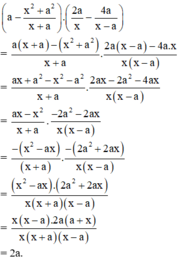A=5x42017-42018-1 phần 1+4+42+.....+42016 . Chứng tỏ rằng biểu thức A có giá trị là một số nguyên
Hãy nhập câu hỏi của bạn vào đây, nếu là tài khoản VIP, bạn sẽ được ưu tiên trả lời.


Để A nguyên mà 32018 + 1 > 5 thì phải cm 32018 + 1\(⋮\)5
Bài giải
Ta có: A = \(\frac{3^{2018}+1}{5}\)
Xét chữ số tận cùng của 32018:
Ta có:
32018 = 34.504 + 2 = 34.504.32 = (...1).32 = (...1).9 = (...9)
Xét 32018 + 1:
32018 + 1 = (...9) + 1 = (...0)
Vì 32018 + 1 có chữ số tận cùng là 0
Nên 32018 + 1 \(⋮\)5
Suy ra A thuộc Z
=> Đpcm

\(C=\frac{2\left(x-1\right)^2+1}{\left(x-1\right)^2+2}\)
a, Ta thấy \(\left(x-1\right)^2\ge0\forall x\Rightarrow\hept{\begin{cases}2\left(x-1\right)^2+1\ge1>0\\\left(x-1\right)^2+2\ge2>0\end{cases}}\)
\(\Rightarrow C>0\forall x\)(đpcm)
b, \(C=\frac{2\left(x-1\right)^2+1}{\left(x-1\right)^2+2}=\frac{2\left(x-1\right)^2+4-3}{\left(x-1\right)^2+2}=2-\frac{3}{\left(x-1\right)^2+2}\)
\(C\in Z\Leftrightarrow2-\frac{3}{\left(x-1\right)^2+2}\in Z\)
\(\Leftrightarrow\frac{3}{\left(x-1\right)^2+2}\in Z\)Lại do \(\left(x-1\right)^2+2\ge2\)
\(\Leftrightarrow\left(x-1\right)^2+2\inƯ\left(3\right)=\left\{3\right\}\)
\(\Leftrightarrow\left(x-1\right)^2\in\left\{1\right\}\)
\(\Leftrightarrow x\in\left\{0\right\}\)
....
c, \(C=2-\frac{3}{\left(x-1\right)^2+2}\)
Ta có : \(\left(x-1\right)^2+2\ge2\Rightarrow\frac{3}{\left(x-1\right)^2+2}\le\frac{3}{2}\)
\(\Rightarrow C=2-\frac{3}{\left(x-1\right)^2+2}\ge2-\frac{3}{2}=\frac{1}{2}\)
Dấu "=" xảy ra khi \(x-1=0\Leftrightarrow x=1\)
:33

Rút gọn biểu thức ta có:

Với a là một số nguyên thì giá trị biểu thức bằng 2a là một số chẵn.

a) A = \(\dfrac{1}{x-1}-\dfrac{4}{x+1}+\dfrac{8x}{\left(x-1\right)\left(x+1\right)}\)
= \(\dfrac{x+1-4x+4+8x}{\left(x-1\right)\left(x+1\right)}=\dfrac{5x+5}{\left(x-1\right)\left(x+1\right)}=\dfrac{5}{x-1}\) => đpcm
b) \(\left|x-2\right|=3=>\left[{}\begin{matrix}x-2=3< =>x=5\left(C\right)\\x-2=-3< =>x=-1\left(L\right)\end{matrix}\right.\)
Thay x = 5 vào A, ta có:
A = \(\dfrac{5}{5-1}=\dfrac{5}{4}\)
c) Để A nguyên <=> \(5⋮x-1\)
| x-1 | -5 | -1 | 1 | 5 |
| x | -4(C) | 0(C) | 2(C) | 6(C) |

A) A = \(\frac{\left(a^3+a^2\right)+\left(a^2-1\right)}{\left(a^3+a^2\right)+\left(a^2+a\right)+\left(a+1\right)}=\frac{a^2\left(a+1\right)+\left(a+1\right)+\left(a+1\right)}{a^2\left(a+1\right)+a\left(a+1\right)+\left(a+1\right)}=\frac{\left(a+1\right)\left(a^2+a-1\right)}{\left(a+1\right)\left(a^2+a+1\right)}=\frac{a^2+a-1}{a^2+a-1}=1\)
b) Gọi Q = ƯCLN ( a2 + a - 1; a2 + a + 1 )
a2 + a - 1 chia hết cho Q
a2 + a + 1 chia hết cho Q
\(\Rightarrow\)( a2 + a + 1 ) - ( a2 + a - 1 ) chia hết cho Q \(\Rightarrow\)2 chia hết cho Q
\(\Rightarrow\)Q chỉ có thể bằng 1 hoặc 2
Ta thấy : a2 + a - 1 = a ( a + 1 ) - 1. Với số nguyên a, ta có :
a ( a + 1 ) là tích của 2 STN liên tiếp, nên : a ( a + 1 ) chia hết cho 2
\(\Rightarrow\)a ( a + 1 ) - 1 là số lẻ
Vậy : a2 + a - 1 là số lẻ
Vậy, d = 1 ( đpcm )

Câu 1:
a) \(A=\left[\dfrac{2}{3x}-\dfrac{2}{x+1}.\left(\dfrac{x+1}{3x}-x-1\right)\right]:\dfrac{x-1}{x}\)
\(=\left[\dfrac{2}{3x}-\dfrac{2}{3x}+\dfrac{2x}{x+1}+\dfrac{2}{x+1}\right]\dfrac{x}{x-1}\)
\(=\left[\dfrac{2x}{x+1}+\dfrac{2}{x+1}\right]\dfrac{x}{x-1}\)
\(=\dfrac{2x+2}{x+1}.\dfrac{x}{x-1}\)
\(=\dfrac{2\left(x+1\right)}{x+1}.\dfrac{x}{x-1}\)
\(=2.\dfrac{x}{x-1}\)
\(=\dfrac{2x}{x-1}\)
Câu 1:
ĐKXĐ: \(x\notin\left\{0;-1;1\right\}\)
a) Ta có: \(A=\left(\dfrac{2}{3x}-\dfrac{2}{x+1}\cdot\left(\dfrac{x+1}{3x}-x-1\right)\right):\dfrac{x-1}{x}\)
\(=\left(\dfrac{2}{3x}-\dfrac{2}{x+1}\cdot\left(\dfrac{x+1}{3x}-\dfrac{3x\left(x+1\right)}{3x}\right)\right):\dfrac{x-1}{x}\)
\(=\left(\dfrac{2}{3x}-\dfrac{2}{x+1}\cdot\dfrac{x+1-3x^2-3x}{3x}\right):\dfrac{x-1}{x}\)
\(=\left(\dfrac{2}{3x}-\dfrac{2}{x+1}\cdot\dfrac{-3x^2-2x+1}{3x}\right):\dfrac{x-1}{x}\)
\(=\left(\dfrac{2\left(x+1\right)}{3x\left(x+1\right)}-\dfrac{2\cdot\left(-3x^2-2x+1\right)}{3x\left(x+1\right)}\right):\dfrac{x-1}{x}\)
\(=\dfrac{2x+2+6x^2+4x-2}{3x\left(x+1\right)}:\dfrac{x-1}{x}\)
\(=\dfrac{6x^2+6x}{3x\left(x+1\right)}:\dfrac{x-1}{x}\)
\(=\dfrac{6x\left(x+1\right)}{3x\left(x+1\right)}:\dfrac{x-1}{x}\)
\(=2\cdot\dfrac{x}{x-1}=\dfrac{2x}{x-1}\)
b) Để A nguyên thì \(2x⋮x-1\)
\(\Leftrightarrow2x-2+2⋮x-1\)
mà \(2x-2⋮x-1\)
nên \(2⋮x-1\)
\(\Leftrightarrow x-1\inƯ\left(2\right)\)
\(\Leftrightarrow x-1\in\left\{1;-1;2;-2\right\}\)
\(\Leftrightarrow x\in\left\{2;0;3;-1\right\}\)
Kết hợp ĐKXĐ, ta được: \(x\in\left\{2;3\right\}\)
Vậy: Để A nguyên thì \(x\in\left\{2;3\right\}\)